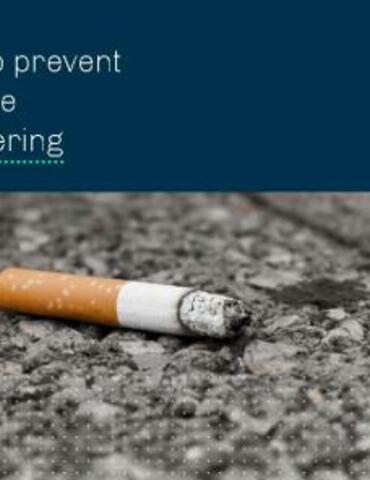Reducing cigarette butt litter
The Program includes guidelines and resources for stakeholders to tackle local cigarette butt litter hotspots, a new grants program and a broader behaviour change campaign.
Why tackle cigarette butt litter?
The National Litter Index shows that cigarette butts are consistently the most-littered item in NSW. It is estimated that each year 1.32 billion cigarette butts are littered in NSW. Cigarette butts are unsightly, toxic and harmful to the environment. They are easily carried in stormwater runoff through drainage systems and eventually to local streams, rivers, and waterways. Cigarette filters contain cellulose acetate, a form of plastic that does not readily biodegrade and can persist in the environment.
Research
Extensive research has been completed to understand smokers’ behaviour, attitudes, and knowledge towards cigarette butt disposal. This includes understanding the barriers and incentives to breaking habits and adopting appropriate butt disposal actions.
This research helped to guide the development of interventions and strategies to influence smokers’ disposal behaviour. These strategies were later tested in a behaviour change trial, to determine the most effective strategies to reduce cigarette butt litter.
EPA-led research into cigarette butt litter and littering behaviour:
Butt litter prevention projects community impact survey
As part of the Cigarette Butt Litter program’s monitoring and evaluation framework, and as agreed with NSW Department of Health, the EPA conducted targeted research to measure the community impact of interventions funded by round one of the Butt Litter Prevention Grants, including any unintended or negative impacts. This will help to inform the development of subsequent rounds and provide early indications of how the Cigarette Butt Litter Prevention Program is likely to impact on local communities.
The survey examined whether the program encourages smoking, and whether there are any impacts on the wider non-smoking community in those areas, including risks such as smoke drift. The project also assessed the effectiveness of the new creative assets including new stencils, signage and messaging used by grantees and the impact of enforcement on reducing smoking at the site.
The research uncovered strong support for the changes introduced by the grant projects. Across the grant sites, 89% of community members indicated they supported the new infrastructure in the area; with benefits far outweighing perceived disadvantages or concerns.
NSW butt litter index
The EPA has recently completed its third Butt Litter Index (BLI) across NSW. The BLI conducts the Butt Litter Check (BLC) at over 110 locations across the state every two years. This best practice methodology monitors the cigarette butt littering rate and explores why people bin or litter their butts.
In 2024, 2,477 out of 4,423 smokers were observed littering their butt, resulting in a butt littering rate of 56%. The BLI will track NSW’s progress towards decreasing the cigarette butt littering rate by 50% by 2030 and helps assess the performance of litter prevention initiatives including the Litter Prevention Grants Program.
The 2024 edition includes five smoker interviews, providing powerful insights into the relationship between smokers and their local surroundings as well as contemporary attitudes towards cigarette butt littering.
- Read the Butt litter 2024 report (PDF 4MB)
- Read the Butt litter 2022 report (PDF 5MB)
- Read the Butt litter index 2020 report (PDF 2MB)
NSW cigarette butt litter prevention trial
In 2018, the NSW EPA led a collaborative behaviour change trial in partnership with 16 local councils to understand what strategies are effective in reducing cigarette butt littering behaviour. Four key strategies were tested across 40 smoking sites.
Trial outcomes show binning rates increased from 38% to 58% (a 53% increase in binning behaviour). For some strategies a peak binning rate of 76% was achieved (a 144% increase in binning behaviour). The Trial provided significant insight into how to improve smoker’s binning behaviour.
Understand your problem: butt litter check
The EPA has developed the 'Butt Litter Check' tool to help understand why smokers may be littering cigarette butts and how to develop targeted ways to stop this behaviour.
The Butt Litter Check Guidelines (PDF 2.1MB) will take you through the four steps involved. A Butt Litter Check should take around 30 minutes to complete at each smoking area and will include at least one 15-minute observation session of smoker disposal actions in each area.
The Butt litter check tool contains the following key steps
- smoking area inspection form (PDF 138KB)
- observation form (PDF 542KB)
- cigarette butt litter count form (PDF 74KB)
- conversations with smokers (PDF 79KB)
The Butt Litter Check was adapted from the 'Local litter check', and targets cigarette-butt littering behaviour.
Guide to prevent cigarette butt littering
The NSW Government has developed a Guide to prevent cigarette butt littering (PDF 1439KB). This Guide provides detailed steps for land managers, local government, businesses and community groups to prevent cigarette butts from being littered. Applying these steps to public places across NSW can prevent almost 800 million cigarette butts from entering the environment.
Download

Guide to prevent cigarette butt littering Guide to prevent cigarette butt littering
